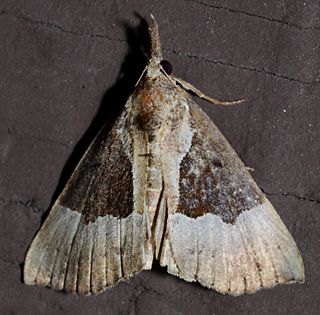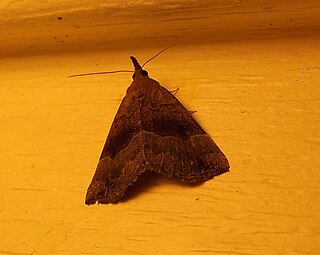
Newell's shearwater or Hawaiian shearwater (ʻaʻo), is a seabird in the family Procellariidae. It belongs to a confusing group of shearwaters which are difficult to identify and whose classification is controversial. It was formerly treated as a subspecies of the Manx shearwater and is now often placed in Townsend's shearwater. It is endemic to the Hawaiian Islands.
Genophantis leahi was a species of moth in the family Pyralidae described by Otto Herman Swezey in 1910. It was endemic to the Hawaiian islands of Maui, Oahu, Molokai and Hawaii.
The Laysan dropseed noctuid moth was a species of moth in the family Erebidae. The species was first described by Otto Herman Swezey in 1914. This species is now extinct.

Hypena is a genus of moths in the family Erebidae. It was first described by Franz von Paula Schrank in 1802. These non-migratory moths overwinter as pupae and almost never estivate as adults.
The lovegrass noctuid moth was a moth in the family Erebidae. The species was first described by Edward Meyrick in 1899. It was endemic to Kauaʻi, Oʻahu, and Maui but is now considered extinct.
The Kaholuamano noctuid moth is an extinct moth in the family Erebidae. The species was first described by Edward Meyrick in 1928. It was endemic to the Hawaiian island of Kauaʻi, but is now considered extinct.

Omiodes is a moth genus in the family Crambidae. Several species are endemic to Hawaii.
Omiodes fullawayi, Fullaway's banana hedyleptan moth, is a species of moth in the family Crambidae. It was described by Otto Herman Swezey in 1913 and is endemic to the island of Hawaii.
Meyrick's banana hedyleptan moth is a species of moth in the family Pyralidae. It was described by Otto Herman Swezey in 1907 and is endemic to the island of Oʻahu in Hawaiʻi.
The Maui banana hedyleptan moth is a species of moth in the family Crambidae. It was described by Otto Herman Swezey in 1909 and is endemic to the Hawaiian islands of Molokai and Maui.

Hypena proboscidalis, the snout, is a moth of the family Erebidae. The species was first described by Carl Linnaeus in his 1758 10th edition of Systema Naturae.

Hypena bijugalis, the dimorphic bomolocha, dimorphic hypena or toothed snout-moth, is a moth of the family Erebidae. The species was first described by Francis Walker in 1859. It is found in North America from Nova Scotia across southern Canada to Vancouver Island, south over the whole United States to Florida.

Hypena madefactalis, the gray-edged hypena or gray-eyed bomolocha, is a moth of the family Erebidae. The species was first described by Achille Guenée in 1854. It is found from extreme southern Canada (Quebec) to Georgia and Texas.

Philodoria is a genus of moths in the family Gracillariidae. All species are endemic to Hawaii. It was first described by Lord Walsingham in 1907.







